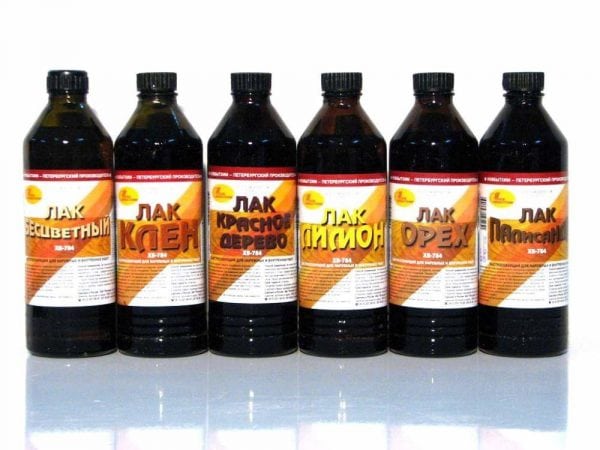Such finishing material as lining, for the most part, already has a decorative protective coating. It is enough to make the cladding and that's it - the room is ready for operation. But in order to increase the resistance of materials to the influence of external factors, to extend the operational life of materials or to give surfaces a new look, you can use lacquer for lining.
Typically, this decorative coating is used for lining made of natural wood. Of course, a certain protective impregnation of the base is already present, and the varnish finish is carried out to give special aesthetic properties and surface protection.
Finishing with colorless varnish allows you to preserve the natural shade of wood, which will not change under the influence of ultraviolet radiation, if natural lining is used as an internal wall cladding on the balcony. Such a protective coating is also used in the interior decoration of the house (not only on the balcony), it is very beautiful.
With the help of pigment varnish, you can saturate the colors of the finish, and with wood - completely transform, creating the effect of a completely different basis. So what varnish to cover the lining?
to contents ↑Types of varnishes for lining
For use inside the house, even on the balcony, it is advisable to choose a harmless chemistry. That is, odorless and the presence of toxic impurities. It is best to paint the surfaces with water-based varnish.
Water-based lacquer for lining can be freely used indoors, as it does not contain organic solvents, which create a specific smell. Water compositions are environmentally friendly, hypoallergenic, relatively durable, and are widely used for wall and ceiling surfaces inside the house, partitions and ceilings, on balconies, loggias and other rooms.
One-component and two-component water-based compositions are distinguished. The latter is preferable due to better surface protection. Paint lining it’s not difficult to do it yourself, because it’s easy to work with the solution. However, the consumption of the protective agent and the application technology (in one, two or more layers) may depend on the quality of the wooden base.
Water-based varnishes have a lot of advantages:
- environmental friendliness;
- lack of a smell that allows to use for internal works;
- fire safety;
- photosensitivity (the coating does not turn yellow and does not change the color of the wood);
- high adhesive properties;
- a certain level of surface protection against mechanical damage;
- ease of use;
- the possibility of tinting.
However, water-based solutions have several disadvantages. They dry longer (due to the weak volatility of the solvent - water). Water-based acrylic varnishes (the most common type of material) are expensive. Before using varnish, the treated surfaces should be properly prepared: clean from dirt and dust, sanded (if necessary).
Outside the house and on the open balcony lined with clapboard, it is better to use alkyd or polyurethane paint and varnish mixtures. This finish will last much longer, reliably protecting the surface from the negative effects of the environment.
to contents ↑A significant drawback of these materials is the emission of harmful substances, since organic solvents are present in the composition.
We carry out protective varnishing of lining
If you want to additionally protect the surfaces lined with wooden clapboard inside the house, on the balcony, covered veranda and so on, you need to properly approach the performance of painting work. As mentioned, before applying the varnish, preparatory work is performed - grinding and cleaning.
To reduce the consumption of the finish coating solution, to increase the adhesion of the varnish to the base materials, it is recommended that the surface be primed. In addition, the primer will improve the protective properties of the decorative layer. The best choice of primer mixture in this case is also water-based (solutions similar in composition interact well with each other).
When the impregnation is completely dry, and it will take from 4 hours to a day (depending on environmental conditions), you can proceed to the next stage of internal finishing work. Inside the house, you can paint the walls with any convenient painting tool: brush, roller, swab, spray.
Before using the solution, it must be thoroughly mixed. A highly viscous substance can be diluted, because varnishes that are more liquid in consistency better stick and give a less thick layer. As a diluent, ordinary water is used. The proportions for dilution are indicated on the product packaging in the instructions for use (technical specifications).
If pigment is present in the varnish solution or you plan to add tint yourself, then the mixture must be mixed very carefully until a uniform color and consistency are obtained.
When working with waterborne varnishes on the balcony and at home, you can not adhere to strict standards of personal protection: glasses, a respiratory mask, gloves. Fresh varnish is easily removed from hands and tools with plain water. But if the solution is dry, special tools will be needed to remove it.
Finishing the interior surfaces of rooms for varnished lining looks very natural. In addition, natural wood materials create a special microclimate in the premises. Staying in them becomes more cozy and comfortable.
Do not save on the quality of materials used for construction and repair work, because this is one of the keys to the success of such an enterprise.








